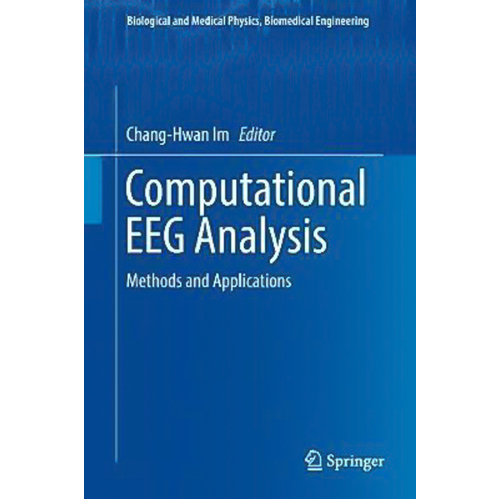Computational EEG Analysis Hardcover Book
Methods and Applications (Biological and Medical Physics
Computational EEG Analysis: Methods and Applications (Biological and Medical Physics, Biomedical Engineering)
Author: Chang-Hwan ImPublisher: Springer Verlag, SingaporeCategory: Pre-clinical Medicine: Basic Sciences, Neurology & Clinical Neurophysiology, Radiology, Biomedical Engineering, Maths For Scientists, Nuclear Structure Physics, Medical Physics, Engineering: General, Biotechnology, Computer ScienceAge Group: 15+Book Format: HardcoverThis book introduces and reviews all of the currently available methods being used for computational electroencephalogram (EEG) analysis, from the fundamentals through to the state-of-the-art. The aim of the book is to help biomedical engineers and medical doctors who use EEG to better understand the methods and applications of computational EEG analysis from a single, well-organized resource.
Following a brief introduction to the principles of EEG and acquisition techniques, the book is divided into two main sections. The first of these covers analysis methods, beginning with preprocessing, and then describing EEG spectral analysis, event-related potential analysis, source imaging and multimodal neuroimaging, and functional connectivity analysis. The following section covers application of EEG analysis to specific fields, including the diagnosis of psychiatric diseases and neurological disorders, brain-computer interfacing, and social neuroscience.
Aimed at practicing medical specialists, engineers, researchers and advanced students, the book features contributions from world-renowned biomedical engineers working across a broad spectrum of computational EEG analysis techniques and EEG applications.
Prof. Chang-Hwan Im graduated from the School of Electrical Engineering of Seoul National University, Korea, in 1999. He received his MS and PhD from the same university in 2001 and 2005, respectively. He worked as a Post-doctor in the Department of Biomedical Engineering at the University of Minnesota, MN, USA, from 2005 to 2006. From 2006 to 2011, he worked for the Department of Biomedical Engineering at Yonsei University, Korea, as an Assistant/Associate Professor. Since 2011, he has been working for the Department of Biomedical Engineering at Hanyang University, Korea, as a Professor. His research interests cover various fields of computational neuroengineering, especially brain-computer interfaces, the diagnosis of neuropsychiatric diseases, noninvasive brain stimulation, bioelectromagnetic source imaging, neuromarketing, and dynamic neuroimaging. He has authored more than 150 articles in peer-reviewed international journals. He is currently a Director of the Computational Neuroengineering Laboratory of Hanyang University, and he is Associate Editors of Biomedical Engineering Letters, Experimental Neurobiology, and Brain-Computer Interfaces.
Table Of Contents
Part I. Introduction Chapter 1. Basics of EEG: Generation, Acquisition and Applications of EEG - Chang-Hwan Im 1.1. Generation of EEG 1.2. Acquisition of EEG 1.3. Computational EEG Analysis 1.4. Applications of EEG Part II. Methods Chapter 2. Preprocessing of EEG - Sung-Phil Kim 2.1. Introduction 2.2. Early-Stage Preprocessing 2.3. Artifact Removal 2.4. Discussion Chapter 3. EEG Spectral Analysis - Do-Won Kim and Chang-Hwan Im 3.1. Introduction 3.2. Methodological Background 3.3. Practical Remarks on EEG Spectral Analysis Chapter 4. The Analysis of Event-Related Potentials - Marco Congedo 4.1. Introduction 4.2. General Considerations in ERP Analysis 4.3. Time Domain Analysis; 4.4. Time-Frequency Domain Analysis 4.5. Spatial Domain Analysis 4.6. Inferential Statistics 4.7. Single-Sweep Classification Chapter 5. EEG Source Imaging and Multimodal Neuroimaging - Yingchun Zhang 5.1. From the Brain to the Scalp - the Forward Problem 5.2. From the Scalp to the Brain - the Inverse Problem 5.3. Multimodal Integration 5.4. Conclusion Chapter 6. Methods for Functional Connectivity Analysis - Jeong-Woo Choi and Kyung-Hwan Kim 6.1. Introduction 6.2. Procedure for the FCA 6.3. FC Metrics 6.4. Volume Conduction Problem 6.5. EEG FC Analysis on Source Space 6.6. Determination of Significance 6.7. Conclusions Part III. Applications Chapter 7. Computational EEG Analysis for the Diagnosis of Psychiatric Illnesses - Seung-Hwan Lee and Yeonsoo Park 7.1. Introduction 7.2. Promising EEG Biomarker Candidates 7.3. Psychiatric Disorders and EEG Biomarkers 7.4. Diagnosis for Cognitive impairment: Dementia and Minimal Cognitive Impairment 7.5. Conclusion Chapter 8. Analysis of EEG in Medically Intractable Epilepsy - Ki-Young Jung 8.1. Overview of Epilepsy and Epilepsy Surgery 8.2. EEG Source Imaging 8.3. High Frequency Oscillation (HFOs) Chapter 9. Computational EEG Analysis for Brain-Computer Interfaces - Garett D. Johnson and Dean J. Krusienski 9.1 Brain-Computer Interfaces 9.2. Active Paradigms 9.3. Reactive Paradigms 9.4. Other Considerations Chapter 10. EEG Analysis for Hyperscanning and Social Neuroscience - Dan Zhang 10.1. Introduction 10.2. Hyperlink for social perception 10.3. Hyperlink for social interaction 10.4. Future perspectivesAbout Chang-Hwan Im
Prof. Chang-Hwan Im graduated from the School of Electrical Engineering of Seoul National University, Korea, in 1999. He received his MS and PhD from the same university in 2001 and 2005, respectively. He worked as a Post-doctor in the Department of Biomedical Engineering at the University of Minnesota, MN, USA, from 2005 to 2006. From 2006 to 2011, he worked for the Department of Biomedical Engineering at Yonsei University, Korea, as an Assistant/Associate Professor. Since 2011, he has been working for the Department of Biomedical Engineering at Hanyang University, Korea, as a Professor. His research interests cover various fields of computational neuroengineering, especially brain-computer interfaces, the diagnosis of neuropsychiatric diseases, noninvasive brain stimulation, bioelectromagnetic source imaging, neuromarketing, and dynamic neuroimaging. He has authored more than 150 articles in peer-reviewed international journals. He is currently a Director of the Computational Neuroengineering Laboratory of Hanyang University, and he is Associate Editors of Biomedical Engineering Letters, Experimental Neurobiology, and Brain-Computer Interfaces.| SKU | BK-9789811309076 |
| Barcode # | 9789811309076 |
| Brand | Springer Verlag, Singapore |
| Artist / Author | Chang-Hwan Im |
| Shipping Weight | 0.5300kg |
| Shipping Width | 0.160m |
| Shipping Height | 0.010m |
| Shipping Length | 0.230m |
| Assembled Length | 23.400m |
| Assembled Height | 1.400m |
| Assembled Width | 15.600m |
| Type | Hardcover |




